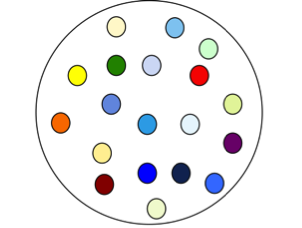At a conference in Burnaby last Spring, the keynote speaker, Shelley Moore, shared a graphic similar to this one. The green circles are typical learners and the red, yellow, and blue circles are people with learning differences.
And then she made the observation that this graphic still promotes a problematic view of being inclusive and shared this graphic with us.
The key difference is that the updated graphic recognizes that there is variation between all of us. By using green to mean typical and the other colours to mean atypical, there is still a false dichotomy created between the two groups of learners. In a practical sense, many disabilities are defined by an arbitrary line drawn on a measure of the range of human ability.
But, we should not ignore the diversity in our learners. Some learners really do need different supports than others. The key is to recognize that many instructional supports intended for some learners are actually helpful for all learners.1 2

All students benefit from sufficient time to think and to process. All students benefit from a public record of what is being discussed. All students benefit from making mathematical ideas explicit. All students benefit from teachers who have high expectations for their capacity to learn.
1. A side note here: there are a small number of disabilities people have which do require very different supports that are unhelpful for other students. In those cases, using targeted support is warranted provided one does so while recognizing the learners are part of the varied tapestry of humanity.
2. These ideas around inclusion for all are also a central theme of the book, Routines for Reasoning.

